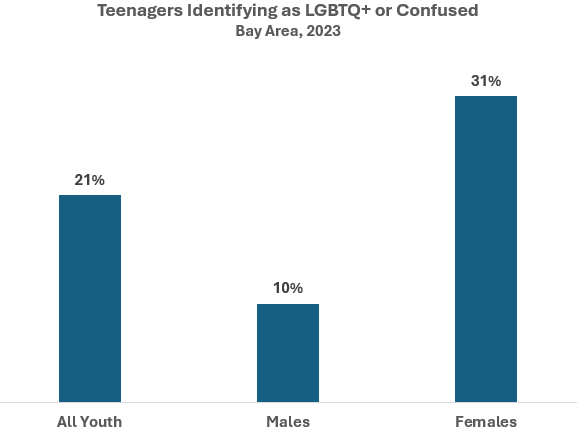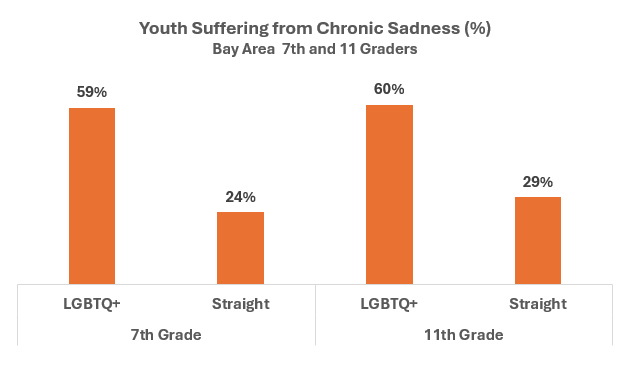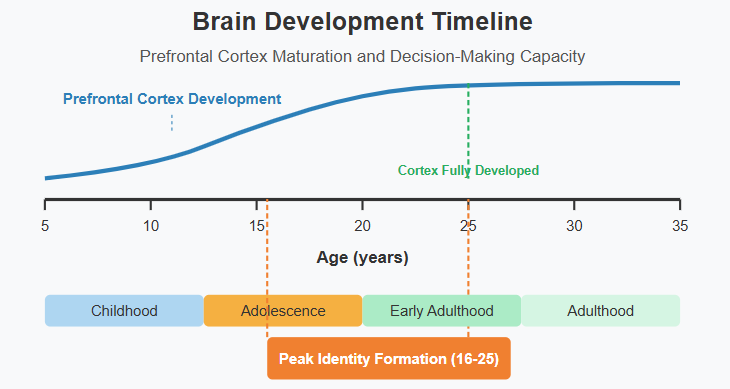Young & Vulnerable: How LGBTQ+ Identification Is Shaping Teen Experiences
Introduction
Following our recent article examining LGBTQ+ identification trends in adults, this week we turn our attention to adolescents and teenagers. Despite widespread efforts to accept and celebrate diverse sexual orientations and gender identities, the data reveal a troubling picture: youth who identify as LGBTQ+ and those questioning their identity face substantially higher risks and challenges.
The scale is significant: 21% of Bay Area teenagers (ages 13-18) identify as LGBTQ+ or express uncertainty—with rates among girls (31%) three times higher than boys (10%).
This substantial portion of youth is navigating identity questions during an already vulnerable developmental period, complicated by early pressures to identify sexually. Today's teenagers also face unprecedented exposure to social media and pornography, with access to information and medical options that can influence significant identity decisions—often before they're developmentally ready.
____________________
Part I: Current Identification Trends
Recent data from the California Health Interview Survey focusing on Bay Area teenagers (ages 13 to 18) reveals noteworthy patterns in sexual orientation:
79% of surveyed teenagers report identifying as straight, while 21% either identify as LGBTQ+ or express confusion about their identity
This combination of LGBTQ+ identification and identity questioning shows significant gender differences
31% of girls either identify as LGBTQ+ or report questioning their identity, compared to 10% of boys—a rate three times higher
____________________
The Department of Education's California Healthy Kids Survey, conducted through participating schools, provides additional insights across specific grade levels. Importantly, this separate data source confirms the trends we've observed, lending greater credibility to our findings.
Data from the largest participating school districts around the Bay Area shows:
At the 7th grade level, approximately 14% of students identify as LGBTQ+
By 11th grade, this figure rises to around 20%
Identification rates vary considerably by school district and geographic location
Among 7th graders, San Francisco Unified School District reported the highest rate at 21%, while Gilroy Unified (in Santa Clara County) reported the lowest at 10%.
For 11th graders, San Francisco Unified again led with 25%, while San Ramon Valley Unified reported the lowest rate at 15%.
____________________
Part II: Associated Risks and Challenges
Despite, or potentially because of, growing focus and societal acceptance, both youth who identify as LGBTQ+ and those questioning their identity face significant challenges. The California Healthy Kids Survey reveals troubling mental health and behavioral disparities between these youth and their straight-identifying peers:
Substance Abuse
Youth who identify as LGBTQ+ or are questioning show dramatically higher rates of substance use:
LGBTQ+ 7th graders: 200% higher rates than straight peers
LGBTQ+ 11th graders: 155% higher rates than straight peers
____________________
Emotional Distress
LGBTQ+ and questioning youth face a disproportionate burden of mental health struggles.
The statistics are stark: approximately 60% of LGBTQ+ youth reported experiencing chronic sadness or hopelessness within the past year, a rate more than double that of their straight-identifying peers.
____________________
Suicidal Ideation
Most concerning are the alarming rates of suicidal thoughts among these vulnerable youth:
40% of LGBTQ+ 7th graders reported having considered suicide in the past year—four times the rate of their straight-identifying peers
35% of LGBTQ+ 11th graders reported similar thoughts—3.5 times higher than straight-identifying students
____________________
Part III: Developmental Context
Understanding adolescent brain development is essential to making sense of the LGBTQ+ identification patterns we observe today. The teenage brain—particularly the prefrontal cortex responsible for decision-making and impulse control—remains under development until approximately age 25.
Meanwhile, peak identity formation occurs between ages 16-25, creating a critical overlap where youth are making significant identity decisions while their brain's decision-making architecture is still developing. Moreover, hormonal surges during puberty affect mood and sexual development, magnifying teens’ vulnerability to identity confusion and mental health challenges.
____________________
Conclusion
The data presented in this article paints a complex picture of LGBTQ+ identification among Bay Area youth. While social acceptance has increased, a significant percentage of teenagers—particularly girls—identify as LGBTQ+ or report questioning their identity, and these young people face troubling mental health disparities compared to their peers.
These patterns take on added significance when viewed through the lens of adolescent development. Young people are navigating complex identity questions during a period when their brains are still developing the capacity for long-term decision-making, all while experiencing the intense biological changes of puberty.
Loving relationships with parents, family members, and positive mentors play a critical role in supporting the mental health and well-being of vulnerable youth. By fostering open communication, stability, and guidance, these relationships help young people navigate the challenges of adolescence. Additionally, limiting exposure to potentially harmful influences such as social media and pornography can further support their well-being.






